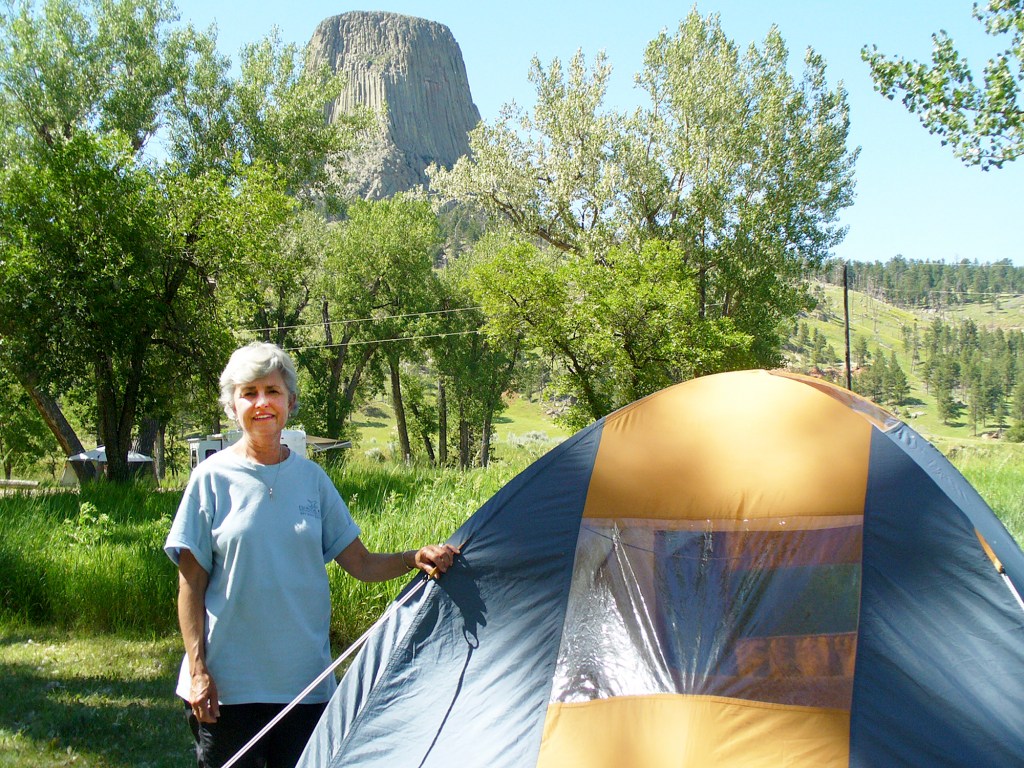Roughing it!
Published 11:00 am Sunday, June 24, 2012

- Devils Tower serves as the backdrop for Kay and David Scott’s tent in Belle Fourche Campground in Wyoming’s Devils Tower National Monument.
We are frequently asked about our favorite national park lodges, but only infrequently about our favorite national park campgrounds. Actually, neither of us can remember the last time anyone asked about the campgrounds even though we have spent many more nights camping in the national parks than staying in the lodges.
The majority of summers during our first three decades of marriage were spent camping in the national parks. And we did so in a series of four VW campers, the first of which (a 1967 model that looked to be straight out of World War II) was so underpowered it was unable to make the minimum speed limit heading west against the wind on a Wyoming interstate. We’ve spent cozy VW nights at Acadia, Everglades, Great Smoky Mountains, Shenandoah, Olympic, Sequoia, Kings Canyon, Glacier, Canyonlands, Lassen Volcanic, Rocky Mountain, Crater Lake, Great Sand Dunes, Grand Canyon, Capitol Reef, Bryce Canyon, Zion, Arches, Badlands, Mammoth Cave, and more. Just as a colonoscopy is the gold standard for checking for potential colon problems, three consecutive months each summer in a VW bus is the gold standard for checking the state of a marriage.
Developing some type of overall ranking for national park lodges is a subjective task because of differing opinions regarding the most important considerations. For example, should room cost be a factor? If so, to what degree? Fortunately, elements of campground desirability tend to be homogeneous. Most of us probably have a preference for a peaceful environment, beautiful scenery, spacious sites offering a degree of privacy, availability of drinkable water and, for females, flush toilets. Showers, of course, are a nice addition. Cost isn’t a differentiating factor for national park campgrounds because camping fees generally fall within a relatively narrow range of $15 to $20 per night. If you are a senior with an America the Beautiful Senior Pass and can camp at half price, so much the better.
So, here are some of our favorite campgrounds. The listing includes only those that are accessible via a typical family vehicle. Therefore, no hike-in or backcountry campgrounds are included. Some of you may prefer wilderness camping, but that can be the subject of an article by a younger reader not currently on Medicare.
Be forewarned that national park campgrounds generally offer modern restrooms, but without showers. Campsites generally do not have hookups although drinking water is available at various locations throughout most campgrounds. Most campsites have a picnic table and grill. Evening programs are often presented by park rangers, although at smaller campgrounds the programs may be offered only on weekends.
Belle Fourche Campground (Devils Tower National Monument, Wyoming): This is perhaps our favorite among all national park campgrounds. Located in a grove of cottonwood trees (unfortunately, lack of water is causing the trees to look pretty shabby), the campground is seldom crowded. Most campers depart relatively early in the morning after staying only one night. Thus, we nearly always have the campground to ourselves throughout most of the day.
A number of campsites offer excellent views of Devils Tower. A trail leads from the campground through a prairie-dog town to the visitor center at the base of the tower. Another meanders along the Belle Fourche River.
Two Medicine Campground (Glacier National Park, Montana): Two Med is a great location to appreciate this wonderful park without the crowds. Located about 13 miles from East Glacier, the campground is near peaceful Two Medicine Lake and a camp store that was constructed as a chalet by the Northern Pacific Railroad. Many of the nearly 100 sites provide shade while a shuttle offers transportation to locations along the east side of the park. Red Bus tours also make a stop here.
Kalaloch Campground (Olympic National Park, Washington): It would be difficult to find a campground with a more spectacular setting than this relatively large unit (170 sites) that sits on a bluff overlooking the Pacific Ocean. The driftwood-covered beach below offers a world-class place to stroll, and dozing off with the sounds of circling gulls and the ocean’s roar isn’t a bad way to spend part of a lazy afternoon. Fog, mist, and wind are frequent visitors to the Washington coast, but this is all part of the coastal experience. Kalaloch Lodge is a short walk north so a warm restaurant with hot coffee isn’t far from your campsite. During our first drive to Kalaloch many years ago, the fog in the distance was so thick that we were certain a major forest fire was in progress.
Signal Mountain Campground (Grand Teton National Park, Wyoming): Situated in a grove of fir and spruce trees, Signal Mountain is an ideal location from which to explore the Jackson Lake and Jenny Lake areas of Grand Teton National Park. Even with nearly 100 sites, the campground fills very early from June through August. Groceries, supplies, and meals are nearby at Signal Mountain Lodge. Although views of the mountains and lake are not available from all campsites, a short walk will reveal some of the most spectacular scenery found anywhere in the country.
Manzanita Lake Campground (Lassen Volcanic National Park, California): This large campground (179 sites) has been a favorite since our first visit in the mid-1970s. In a pine forest at 6,000 feet, the cool summer temperatures are a welcome relief for travelers who have driven up from the hot and dry Central Valley. The giant sugar pines drop cones so large they could stagger Mike Tyson if he ever decides to camp here. A path circling Manzanita Lake leads to Loomis Museum and its exhibits that document the 1914-1917 volcanic eruptions here. Bring a canoe or inflatable raft and enjoy a quiet morning paddling the lake.
Fruita Campground (Capitol Reef National Park, Utah): One of the most unusual and enjoyable campgrounds found in any national park, Fruita is set amid an orchard maintained by the National Park Service. We haven‘t camped here for some time, but we have pleasant memories of picking apricots, apples, and cherries, the latter of which were eaten with such abandon that we both got sick. The National Park Service description of the campground as “an oasis within a desert” is spot on. We camped here one Fourth of July and drove down the road to the small town of Torrey to take in the holiday parade.
Sentinel Campground (Kings Canyon National Park, California): Sentinel is one of four campgrounds in the Cedar Grove area of the park. Actually, any of the four would be on our favorites list because we consider Cedar Grove such a great place to camp, but Sentinel is closest to Cedar Grove Lodge with a small market and dining area. The campground sits along the Middle Fork of the Kings River that can really roar in the spring and early summer.
Chisos Basin Campground (Big Bend National Park, Texas): Surrounded by high cliffs, this 60-site campground is in an area that offers hiking, beautiful night skies, and a chance to see some javelina — a strange-looking, pig-like mammal — chow down on a cactus or two. The campground isn’t far from Chisos Mountains Lodge which offers a market and restaurant. One night while camping here we heard a commotion from a nearby campsite. It turned out that a skunk had gotten into a tent. The commotion was from the human occupants, not the skunk.
Rocky Knob Campground (Blue Ridge Parkway, North Carolina): We have generally considered the Blue Ridge Parkway to have some of the National Park Service’s most pleasant campgrounds. In fact, it is difficult to choose which is best among the nine that are along this 469-mile drive. Rocky Knob Campground at milepost 161 is certainly near the top of the list, in part because it is only nine miles from Mabry Mill and its excellent breakfast biscuits. Some campsites are in the deep woods while others are more open. An attractive picnic area is next to the campground.
Juniper Campground (Theodore Roosevelt National Park, North Dakota): Located in the badlands of western North Dakota, this national park has always been one of our favorites. We prefer smaller Juniper Campground in the park’s north unit to Cottonwood Campground in the more popular south unit. Juniper Campground sits beside the Little Missouri River in an especially scenic area of the badlands. This unit of the park is distant from the interstate so it is quieter and receives fewer visitors. A visit to the small town of Medora near the south unit is a must.
David and Kay Scott are authors of “Complete Guide to the National Park Lodges.” They live in Valdosta.





